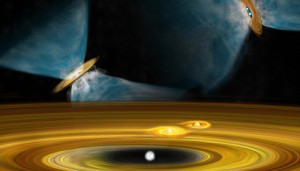An early peek at a forming star system reveals tantalizing clues about its origin.

Bill Saxton (NRAO) / AUI / NSF
Nature closely guards the recipe for cooking stars and planets. Sure, theoretical models and observations have allowed astronomers to decipher the overall picture. We know the basics of how a cold cloud of dust and gas transforms into a hydrogen-fusing nuclear reactor that burns for billions of years, and how tiny grains grow to orbs large enough to support millions of species. But the details remain hazy.
A new radio survey, however, is giving astronomers a new peek at nature’s cookbook. For 264 hours, the Very Large Array’s 27 antennas pointed toward Perseus, where a nearby molecular cloud contains 100 newborn stars. The survey’s angular resolution proved better than the Hubble Space Telescope’s, allowing astronomers to see more clearly than ever before. A previously known triple star system within the massive cloud, for example, turned out to be a sextuple system — one star was actually two, and another was actually three.
“We’re detecting the formation of structures that are smaller than our own solar system,” said John Tobin (Leiden Observatory, The Netherlands), when he presented his team’s results at the American Astronomical Society (AAS) meeting in Kissimmee, Florida.
Multiple Paths at Play
Stars are born in enormous clouds of gas and dust. Small pockets in these clouds collapse under the pull of gravity. But as the pockets begin to shrink, their inner region start to spin, and everything beyond quickly flattens into a pancake-like disk. Finally, the central clump becomes so hot and dense that its core ignites via nuclear fusion, while the outer disk coagulates to form planets.
But this basic blueprint is a tad oversimplified because often the condensing cloud doesn’t yield just one star; it gives you more. Half of Sun-like stars, for example, actually exist in binary or multiple-star systems — so astronomers want to know how these differ in formation from our own.
From the survey, Tobin’s team noticed that most binary star systems fall into two categories: they’re either separated by less than 300 astronomical units (1 a.u. is the mean Earth-Sun distance) or instead by a distance greater than 1,000 a.u. “We think this is evidence that they form from distinct routes,” said Tobin. More than one recipe might be in the mix of outcomes.
For example, in the closer multiple-star systems, one star likely forms in its birth cloud's dense central core, while any companion stars come together nearby within the orbiting disk. For the more widely-separated multiple-star systems, maybe each star forms within the turbulent fragmentation of its parent cloud. Since most of the widely separated systems are relatively young, the team speculates that they must tend to drift apart over time.
An Earlier Start than Expected
The wealth of data found in this survey has led to more than just one intriguing result. Another team, including Dominique Segura-Cox, a graduate student at the University of Illinois, probed the dusty disks surrounding the young stars in order to better understand how any orbiting planets form.
Before the survey, only three disks had been observed at such an early stage of evolution. The VLA survey, however, discovered 18 planet-forming disks. “This is the tip of the iceberg,” said Segura-Cox, when she presented her team’s results at the AAS meeting. She suspects that once astronomers probe smaller and smaller structures, they’ll find plenty more disks around young stars within the rich Perseus Molecular Cloud.
It wasn’t necessarily the abundance of these disks that surprised astronomers the most, but rather the size of the dust grains within them. The survey probed a radio wavelength of 8 mm, which directly traces the size of the grains within the disk. At such an early stage, astronomers expect to see relatively small grains. “But 8 mm is not dust grains, it’s not sand, it’s not specks,” said Segura-Cox. “It’s peas, it’s pebbles, it’s rocks.”
And such large grains so early on might accelerate planets’ formation. “If they don’t have to start at this stage of evolution from specks, they can start from pebbles instead, disks may be helping to boost planet formation earlier than we ever thought.” Maybe nature’s recipe calls for dust that’s diced and not minced.
References:
John Tobin et al. “ The VLA Nascent Disk and Multiplicity Survey of Perseus Protostars (VANDAM). II. Multiplicity of Protostars in the Perseus Molecular Cloud.”Astrophysical Journal. November 1, 2015.
Erin Cox et al. “High Resolution 8 mm and 1 cm Polarization of IRAS 4A from the VLA Nascent Disk and Multiplicity (VANDAM) Survey.”Astrophysical Journal Letters. January 4, 2016.
 0
0









Comments
You must be logged in to post a comment.